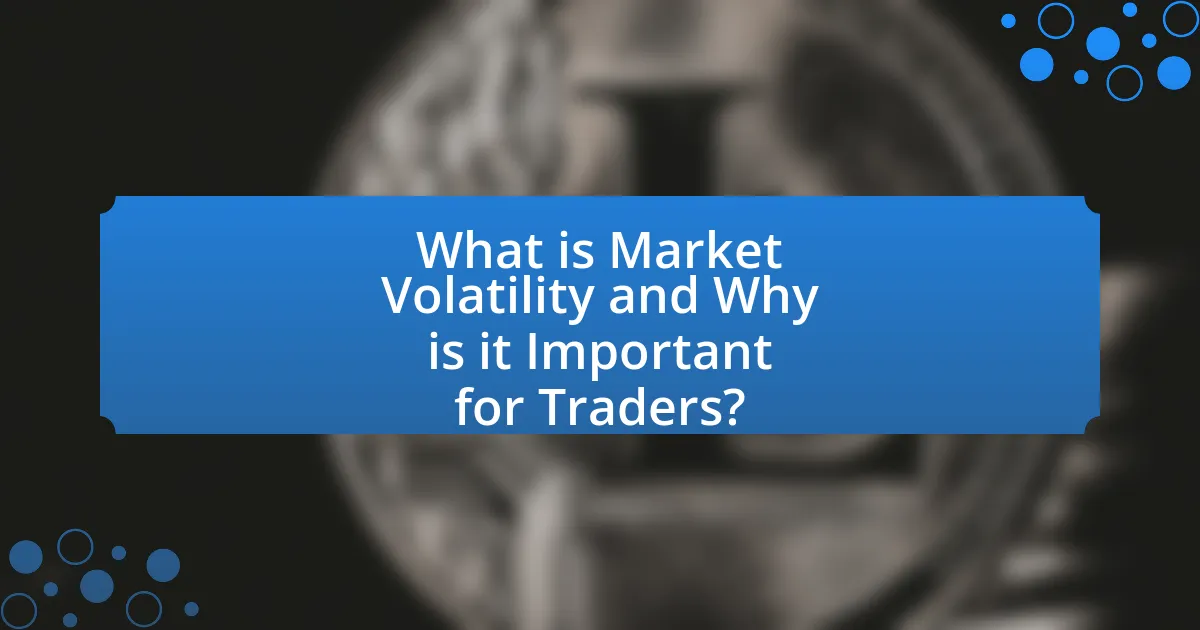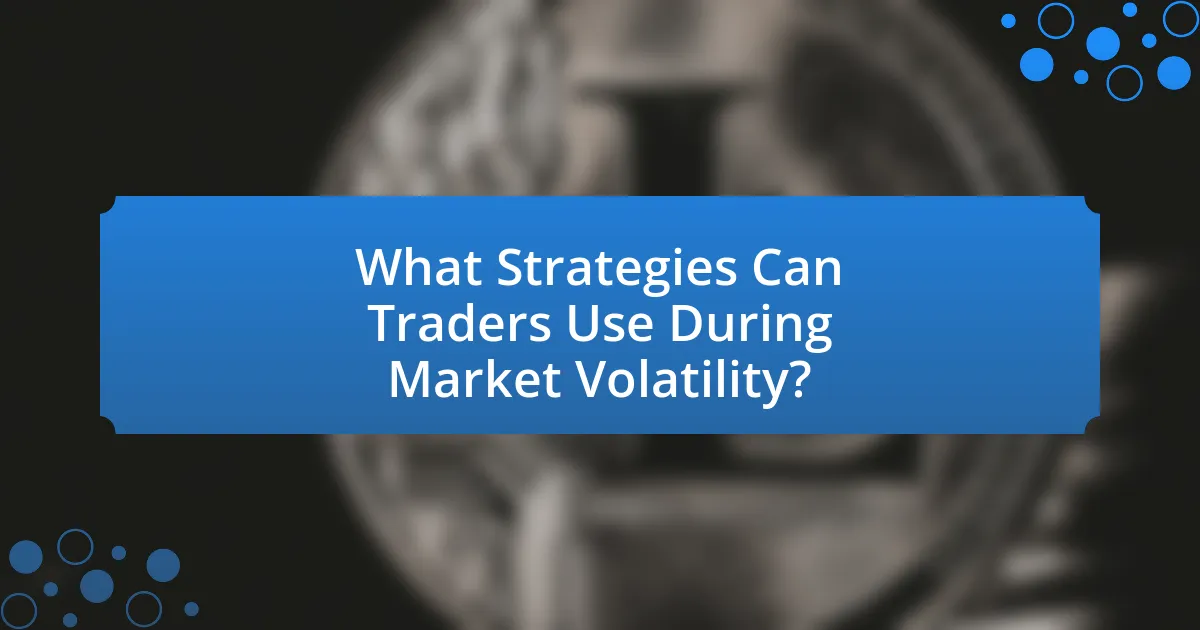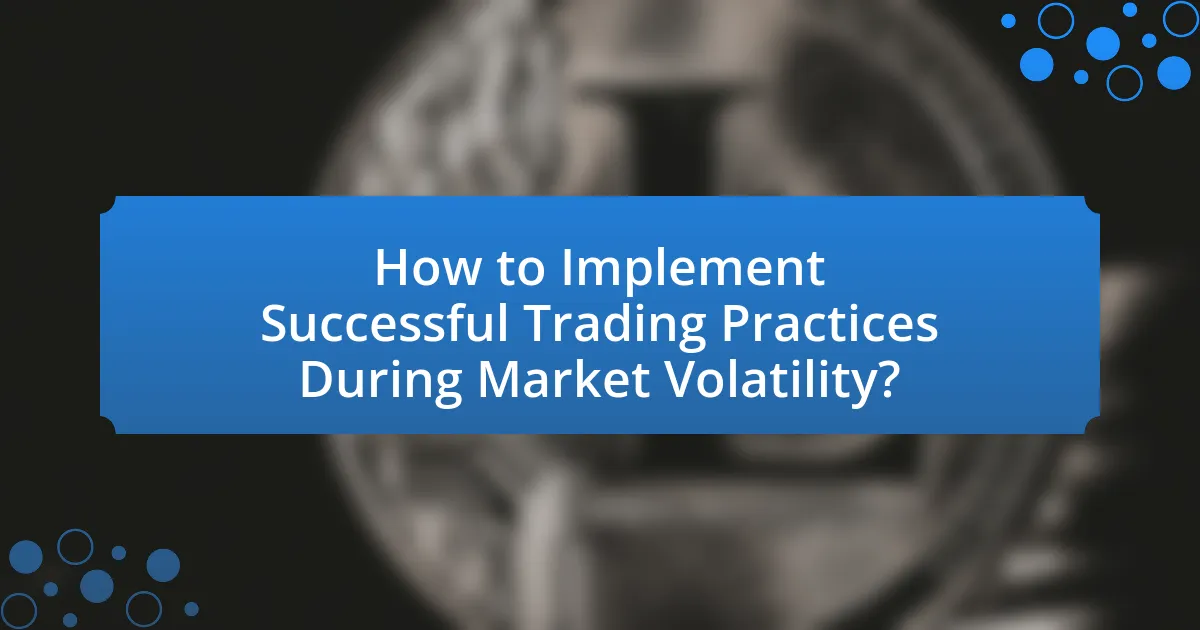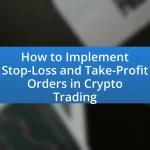Market volatility is a critical concept for traders, representing the degree of price fluctuations in financial assets over time. This article explores the significance of market volatility, its causes, and its impact on trading decisions. Key indicators such as the VIX index and economic factors are examined, alongside strategies for managing risk during volatile periods, including diversification, stop-loss orders, and technical analysis. Additionally, the article addresses the psychological aspects of trading in volatile markets and offers practical tips for enhancing trading success, emphasizing the importance of disciplined approaches and performance evaluation.

What is Market Volatility and Why is it Important for Traders?
Market volatility refers to the degree of variation in trading prices over time, indicating the level of uncertainty or risk in the market. It is important for traders because it creates opportunities for profit through price fluctuations; higher volatility often leads to larger price swings, which can be exploited for gains. Historical data shows that during periods of increased volatility, such as the 2008 financial crisis, traders who effectively managed risk and capitalized on price movements could achieve significant returns. Understanding market volatility allows traders to make informed decisions, adjust their strategies, and implement risk management techniques to navigate uncertain market conditions effectively.
How is market volatility defined?
Market volatility is defined as the degree of variation in the price of a financial asset over time, typically measured by the standard deviation of returns. This concept indicates how much the price of an asset fluctuates, with higher volatility signifying greater price swings and uncertainty in the market. For example, the CBOE Volatility Index (VIX) quantifies market expectations of near-term volatility, often reflecting investor sentiment and market conditions.
What are the key indicators of market volatility?
The key indicators of market volatility include the VIX index, historical price fluctuations, trading volume, and economic indicators such as unemployment rates and GDP growth. The VIX index, often referred to as the “fear gauge,” measures market expectations of near-term volatility based on S&P 500 index options, with higher values indicating greater expected volatility. Historical price fluctuations provide insight into past market behavior, while increased trading volume often correlates with heightened volatility, signaling investor uncertainty. Economic indicators, such as rising unemployment rates or fluctuating GDP growth, can also contribute to market volatility by affecting investor sentiment and market stability.
How does market volatility impact trading decisions?
Market volatility significantly influences trading decisions by affecting risk assessment and strategy formulation. Traders often react to increased volatility by adjusting their positions, employing stop-loss orders, or opting for hedging strategies to mitigate potential losses. For instance, during periods of high volatility, such as the 2008 financial crisis, traders frequently shifted to safer assets, demonstrating a clear correlation between volatility and asset allocation. This behavior is supported by research indicating that volatility can lead to heightened uncertainty, prompting traders to either capitalize on price swings or retreat to more stable investments.
What causes market volatility?
Market volatility is primarily caused by changes in investor sentiment, economic indicators, geopolitical events, and market speculation. Investor sentiment can shift rapidly due to news or events, leading to increased buying or selling pressure. Economic indicators, such as unemployment rates or inflation data, can also influence market perceptions and trigger volatility. Geopolitical events, like conflicts or elections, create uncertainty, prompting investors to react swiftly. Additionally, speculative trading can amplify price movements, as traders react to short-term trends rather than long-term fundamentals. Historical data shows that significant market events, such as the 2008 financial crisis, resulted in extreme volatility due to a combination of these factors.
How do economic indicators influence market volatility?
Economic indicators significantly influence market volatility by providing insights into the health of an economy, which can lead to rapid changes in investor sentiment and market behavior. For instance, when key indicators such as GDP growth, unemployment rates, or inflation figures are released, they can either reassure investors or create uncertainty. Historical data shows that unexpected changes in these indicators often result in sharp market movements; for example, a stronger-than-expected jobs report can lead to a surge in stock prices, while disappointing economic data can trigger sell-offs. This relationship underscores the importance of economic indicators in shaping market expectations and driving volatility.
What role do geopolitical events play in market fluctuations?
Geopolitical events significantly influence market fluctuations by creating uncertainty and altering investor sentiment. For instance, events such as military conflicts, trade disputes, or political instability can lead to volatility in stock prices, currency values, and commodity markets. Historical examples include the 2008 financial crisis, which was exacerbated by geopolitical tensions, and the market reactions to the U.S.-China trade war, where tariffs imposed led to sharp declines in stock indices. These events often trigger risk aversion among investors, prompting them to move assets into safer investments, thereby affecting overall market dynamics.
Why should traders be concerned about market volatility?
Traders should be concerned about market volatility because it directly impacts the risk and potential returns of their investments. High volatility can lead to rapid price fluctuations, which may result in significant gains or losses within short time frames. For instance, during the 2008 financial crisis, the S&P 500 experienced a volatility index (VIX) spike above 80, indicating extreme market uncertainty, which caused many traders to incur substantial losses. Understanding and managing this volatility is crucial for traders to protect their capital and make informed trading decisions.
What risks does market volatility pose to traders?
Market volatility poses significant risks to traders, primarily through increased potential for financial loss and emotional stress. The rapid price fluctuations can lead to unexpected losses, as traders may execute trades based on short-term market movements rather than informed strategies. According to a study by the CFA Institute, high volatility periods can result in a 20% increase in the likelihood of traders experiencing losses, as they may react impulsively to market changes. Additionally, the psychological impact of volatility can lead to poor decision-making, further exacerbating financial risks.
How can understanding volatility lead to better trading strategies?
Understanding volatility allows traders to develop more effective trading strategies by enabling them to assess risk and identify potential price movements. By analyzing historical volatility data, traders can determine the likelihood of price fluctuations, which aids in setting appropriate stop-loss orders and position sizes. For instance, during periods of high volatility, traders may opt for shorter time frames and tighter risk management to capitalize on rapid price changes, as evidenced by studies showing that volatility often precedes significant market movements. This informed approach enhances decision-making and can lead to improved trading outcomes.

What Strategies Can Traders Use During Market Volatility?
Traders can use several strategies during market volatility, including diversification, hedging, and employing stop-loss orders. Diversification helps mitigate risk by spreading investments across various assets, reducing the impact of a single asset’s poor performance. Hedging involves using financial instruments, such as options or futures, to offset potential losses in an investment. For instance, during the 2008 financial crisis, many traders utilized options to protect their portfolios from significant downturns. Additionally, implementing stop-loss orders allows traders to automatically sell a security when it reaches a predetermined price, limiting potential losses. These strategies are effective in managing risk and capitalizing on market fluctuations.
How can traders adapt their strategies to volatile markets?
Traders can adapt their strategies to volatile markets by implementing risk management techniques, such as setting tighter stop-loss orders and reducing position sizes. These adjustments help mitigate potential losses during unpredictable price swings. Historical data shows that during periods of high volatility, such as the 2008 financial crisis, traders who employed strict risk management were able to preserve capital and capitalize on market opportunities more effectively than those who did not. Additionally, traders can utilize technical analysis tools, like Bollinger Bands, to identify potential entry and exit points, which can be particularly useful in rapidly changing market conditions.
What are the benefits of using stop-loss orders in volatile conditions?
Using stop-loss orders in volatile conditions helps traders limit potential losses and protect profits. These orders automatically sell a security when its price falls to a predetermined level, which is crucial during periods of high market fluctuations. For instance, during the COVID-19 market crash in March 2020, traders who utilized stop-loss orders were able to mitigate losses as prices rapidly declined, demonstrating the effectiveness of this strategy in protecting capital. Additionally, stop-loss orders can reduce emotional decision-making, allowing traders to stick to their trading plans even in turbulent markets.
How can diversification help mitigate risks during volatility?
Diversification helps mitigate risks during volatility by spreading investments across various asset classes, sectors, or geographic regions, which reduces the impact of poor performance in any single investment. When one asset class experiences a downturn, others may remain stable or even appreciate, thereby cushioning the overall portfolio against significant losses. Historical data shows that diversified portfolios tend to have lower volatility and higher risk-adjusted returns compared to concentrated investments. For instance, during the 2008 financial crisis, diversified portfolios that included a mix of stocks, bonds, and alternative assets experienced less severe declines than those heavily weighted in equities alone.
What trading techniques are effective in volatile markets?
Effective trading techniques in volatile markets include using stop-loss orders, employing options strategies, and implementing trend-following systems. Stop-loss orders help limit potential losses by automatically selling a security when it reaches a predetermined price, which is crucial in fast-moving markets. Options strategies, such as straddles or strangles, allow traders to profit from significant price movements in either direction, providing flexibility in uncertain conditions. Trend-following systems, which rely on technical indicators to identify and capitalize on market trends, can help traders navigate volatility by aligning their positions with prevailing market momentum. These techniques are validated by numerous trading studies that highlight their effectiveness in managing risk and enhancing returns during periods of market instability.
How does day trading differ from swing trading in volatile environments?
Day trading involves executing multiple trades within a single day, capitalizing on short-term price movements, while swing trading focuses on holding positions for several days to weeks to benefit from medium-term trends. In volatile environments, day traders react quickly to price fluctuations, often using technical analysis and real-time data to make rapid decisions, which can lead to higher transaction costs due to frequent trading. Conversely, swing traders may experience larger price swings over their holding period, allowing them to potentially capture more significant moves but also exposing them to overnight risk and market gaps. Historical data shows that day trading can be more profitable in high volatility due to the increased number of trading opportunities, while swing trading may yield better returns in stable trends, highlighting the distinct strategies employed in each approach.
What is the role of technical analysis in trading during volatility?
Technical analysis plays a crucial role in trading during volatility by providing traders with tools to identify price trends and potential reversal points. During volatile market conditions, price movements can be rapid and unpredictable, making it essential for traders to rely on chart patterns, indicators, and historical price data to make informed decisions. For instance, studies have shown that technical indicators like moving averages and Bollinger Bands can help traders gauge market sentiment and volatility levels, allowing them to enter or exit positions more effectively. This reliance on technical analysis can enhance decision-making and risk management, ultimately improving trading outcomes in turbulent markets.
What psychological factors should traders consider during volatility?
Traders should consider emotional regulation, cognitive biases, and risk tolerance during volatility. Emotional regulation is crucial as heightened market fluctuations can trigger fear or greed, leading to impulsive decisions. Cognitive biases, such as overconfidence or loss aversion, can distort a trader’s perception of risk and reward, impacting their judgment. Additionally, understanding one’s risk tolerance helps traders make informed decisions that align with their psychological comfort levels, reducing the likelihood of panic selling or over-leveraging. Research indicates that emotional intelligence significantly influences trading performance, highlighting the importance of these psychological factors in navigating volatile markets.
How can fear and greed affect trading decisions in volatile markets?
Fear and greed significantly influence trading decisions in volatile markets by driving irrational behavior. Traders often succumb to fear during market downturns, leading to panic selling, which can exacerbate price declines. Conversely, during market upswings, greed can prompt traders to chase prices, resulting in overvalued assets and potential losses when corrections occur. Historical data shows that during the 2008 financial crisis, fear led to a 37% drop in the S&P 500, while the subsequent recovery saw a surge driven by greed, with the index rising over 400% by 2021. This cyclical pattern illustrates how emotional responses can distort rational decision-making, ultimately impacting market stability and individual investment outcomes.
What strategies can help traders maintain discipline during market swings?
Traders can maintain discipline during market swings by implementing a well-defined trading plan that includes risk management strategies. A solid trading plan outlines entry and exit points, position sizing, and stop-loss orders, which help traders stick to their strategy despite market fluctuations. Research indicates that traders who adhere to a structured plan are less likely to make impulsive decisions, as evidenced by a study from the Journal of Behavioral Finance, which found that disciplined traders experience lower emotional stress and improved performance during volatile periods. Additionally, maintaining a trading journal can reinforce discipline by allowing traders to review their decisions and learn from past mistakes, further supporting the importance of a systematic approach in volatile markets.

How to Implement Successful Trading Practices During Market Volatility?
To implement successful trading practices during market volatility, traders should adopt a disciplined approach that includes risk management, diversification, and the use of technical analysis. Risk management involves setting stop-loss orders to limit potential losses, which is crucial during unpredictable market movements. Diversification across various asset classes can mitigate risks, as not all assets react similarly to market changes. Technical analysis, including the use of indicators like the Relative Strength Index (RSI) and moving averages, helps traders identify trends and make informed decisions. Historical data shows that traders who employ these strategies tend to perform better during volatile periods, as evidenced by studies indicating that disciplined traders can reduce losses by up to 30% compared to those who do not use risk management techniques.
What are the best practices for trading in volatile markets?
The best practices for trading in volatile markets include implementing risk management strategies, utilizing stop-loss orders, and maintaining a disciplined trading plan. Risk management strategies, such as limiting the amount of capital risked on each trade to a small percentage of the total account, help protect against significant losses during unpredictable market movements. Stop-loss orders automatically close positions at predetermined price levels, minimizing potential losses when the market moves against a trader’s position. Additionally, a disciplined trading plan, which includes clear entry and exit criteria, helps traders avoid emotional decision-making that can lead to poor outcomes in volatile conditions. These practices are supported by historical data showing that traders who adhere to risk management principles tend to achieve better long-term results, even in fluctuating markets.
How can traders set realistic goals during periods of high volatility?
Traders can set realistic goals during periods of high volatility by focusing on achievable profit targets and risk management strategies. During high volatility, price movements can be unpredictable, making it essential for traders to adjust their expectations accordingly. For instance, instead of aiming for large profits, traders should consider smaller, more attainable gains that reflect the increased risk. Additionally, implementing strict stop-loss orders can help manage potential losses, ensuring that traders do not exceed their risk tolerance. Historical data shows that during volatile periods, such as the 2008 financial crisis, many traders who set conservative goals and adhered to risk management principles were able to preserve their capital and remain in the market.
What tools and resources can assist traders in navigating volatility?
Traders can utilize various tools and resources to navigate volatility effectively, including volatility indicators, trading platforms with advanced charting capabilities, and educational resources. Volatility indicators, such as the Average True Range (ATR) and Bollinger Bands, provide insights into market fluctuations, helping traders make informed decisions. Advanced trading platforms like MetaTrader and Thinkorswim offer real-time data and customizable charts, enabling traders to analyze market trends and execute trades swiftly. Additionally, educational resources, including webinars and online courses from reputable financial institutions, equip traders with strategies and risk management techniques essential for trading in volatile markets. These tools and resources collectively enhance traders’ ability to respond to market changes and optimize their trading strategies.
How can traders evaluate their performance during volatile periods?
Traders can evaluate their performance during volatile periods by analyzing key metrics such as the Sharpe ratio, drawdown, and win-loss ratio. The Sharpe ratio measures risk-adjusted returns, allowing traders to assess how much excess return they are receiving for the extra volatility they endure. A lower drawdown indicates better performance, as it reflects the maximum observed loss from a peak to a trough, which is crucial during volatile markets. Additionally, the win-loss ratio helps traders understand their success rate in trades, providing insight into their overall strategy effectiveness. Historical data shows that traders who regularly assess these metrics can adapt their strategies more effectively, leading to improved performance in future volatile conditions.
What metrics should traders track to assess their success in volatile markets?
Traders should track metrics such as volatility measures, win-loss ratio, average return per trade, and drawdown to assess their success in volatile markets. Volatility measures, like the VIX index, indicate market uncertainty and help traders gauge risk. The win-loss ratio reflects the proportion of profitable trades to losing trades, providing insight into trading effectiveness. Average return per trade quantifies the profitability of trades, while drawdown measures the peak-to-trough decline in account equity, highlighting risk management effectiveness. These metrics collectively enable traders to evaluate performance and adjust strategies in response to market fluctuations.
How can traders learn from past experiences to improve future performance?
Traders can learn from past experiences by analyzing their previous trades to identify patterns, mistakes, and successful strategies. This analysis allows traders to understand what factors contributed to their successes or failures, enabling them to refine their decision-making processes. For instance, a study by the CFA Institute found that traders who kept detailed trading journals significantly improved their performance by reflecting on their emotional responses and decision-making criteria. By systematically reviewing past trades, traders can develop a more disciplined approach, adapt their strategies to changing market conditions, and ultimately enhance their future trading outcomes.
What practical tips can enhance trading success during market volatility?
To enhance trading success during market volatility, traders should implement risk management strategies, such as setting stop-loss orders and position sizing. These techniques help limit potential losses and protect capital during unpredictable market movements. Historical data shows that traders who utilize stop-loss orders can reduce their average loss per trade by up to 30%, according to a study by the CFA Institute. Additionally, maintaining a diversified portfolio can mitigate risks associated with volatility, as it spreads exposure across various assets. Research indicates that diversification can lower portfolio risk by approximately 20% compared to concentrated investments. Lastly, staying informed about market news and economic indicators allows traders to make timely decisions, as 70% of market movements are influenced by external events, according to a report by Bloomberg.


